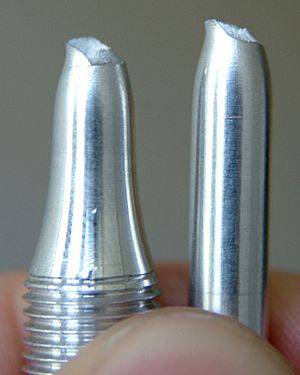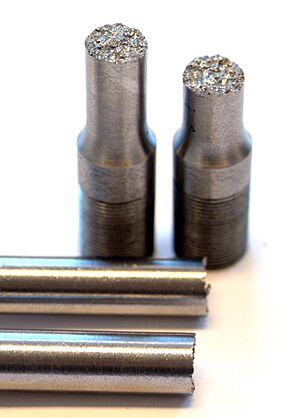Ductility facts for kids
Ductility is a cool property of some solid materials. It means they can be stretched into a long, thin wire without breaking. Imagine pulling on a piece of taffy – that's a bit like ductility!
Another similar property is malleability. This is when a material can be flattened or shaped by hitting it with a hammer or rolling it. Think about how a blacksmith shapes metal – that's using malleability.
Both ductility and malleability are types of plasticity. Plasticity is simply how much a solid material can change its shape without breaking. Metals often show these properties, and how much they can stretch or flatten depends on things like temperature and pressure.
Ductility and malleability don't always go hand-in-hand. For example, gold is super ductile and malleable. You can stretch it into a very thin wire and also hammer it into thin sheets. But lead is different; it's very malleable (easy to flatten) but not very ductile (it doesn't stretch much before breaking). Sometimes, the word ductility is used to describe both types of shaping.
Some common materials with high ductility include gold, copper, aluminium, and steel. These are materials you might see used to make wires or other stretched-out shapes.
Contents
What is Ductility?
Ductility describes how much a material can be stretched or pulled without breaking. When a material is ductile, it can handle a lot of pulling force. This is why we can make long, thin wires out of metals like copper for electrical cables.
How Materials Stretch
When you pull on a ductile material, its tiny parts (atoms) can slide past each other without separating. This allows the material to get longer and thinner. If a material isn't ductile, its atoms can't slide easily, so it will break quickly when pulled.
What is Malleability?
Malleability is about how much a material can be squashed or hammered without breaking. If a material is malleable, you can flatten it into a sheet or shape it easily.
How Materials Flatten
Similar to ductility, malleability also involves the atoms sliding. But instead of being pulled apart, they are pushed together. This allows the material to spread out and change shape under pressure.
Ductility vs. Malleability
While both properties involve a material changing shape without breaking, they are different:
- Ductility is about stretching (like pulling a wire).
- Malleability is about squashing or hammering (like flattening a sheet).
Some materials are good at both, like gold. Others might be good at one but not the other, like lead, which is very malleable but not very ductile.
Common Ductile Materials
Many metals are known for their ductility. Here are a few examples:
- Gold: Gold is one of the most ductile and malleable metals. A single gram of gold can be stretched into a wire over 2 kilometers long!
- Copper: This metal is widely used for electrical wires because it's very ductile and conducts electricity well.
- Aluminium: Aluminium is also quite ductile and is used in many applications, including wiring and foil.
- Steel: Certain types of steel are very ductile, allowing them to be shaped into various forms for construction and manufacturing.
Images for kids
See also
 In Spanish: Ductilidad para niños
In Spanish: Ductilidad para niños




